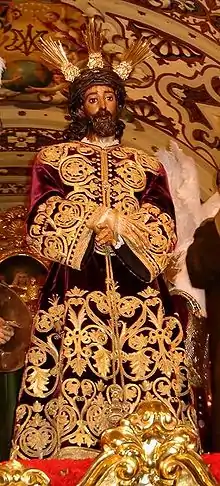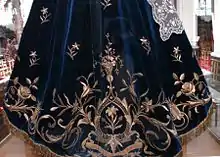Goldwork (embroidery)
Goldwork is the art of embroidery using metal threads, or threads with metal leaf wound round a normal textile thread. It is particularly prized for the way light plays on it. The term "goldwork" is used even when the threads are imitation gold, silver, or copper. The metal wires used to make the threads have never been entirely gold; they have usually been gold-coated silver (silver-gilt) or cheaper metals, and even then the "gold" often contains a very low percent of real gold. Most metal threads are available in silver and sometimes copper as well as gold; some are available in colors as well. A new coating technology however enables the direct coating of 24K gold on a filament yarn without any other metal or adhesive layer underneath.




The same silver and gold thread were also used heavily in the most expensive tapestries, especially during the Renaissance.
Goldwork is always surface embroidery and free embroidery; the vast majority is a form of laid work or couching; that is, the gold threads are held onto the surface of the fabric by a second thread, usually of fine silk. The ends of the thread, depending on type, are simply cut off, or are pulled through to the back of the embroidery and carefully secured with the couching thread. A tool called a mellore or a stiletto is used to help position the threads and create the holes needed to pull them through.
History
Goldwork was originally developed in Asia, and has been used for at least 2000 years. For much of the time, it was generally reserved for garments of the nobility and men of the church. When illiteracy was common and thus written materials had less impact, "images and the visual realm [had] more power over the senses and the mind....The pomp and circumstance created by the awe-inspiring use of metal threads in church work was observed keenly by kings and emulated where possible.[1]:214
Origins in China
It is thought that China is the birthplace of goldwork, and that it migrated from there to Korea and Japan. It also migrated from China to the West with silk merchants. In China, embroidery in gold was to be found on imperial and ceremonial dress.[2]:3 Chinese goldwork often used red silk threads for couching, adding a warmer tone to the embroidery.[3]:22
India
The use of goldwork in India predates the arrival of the Greeks in 365-323 BCE. Indian metal thread embroidery uses precious and semiprecious stones and wire in distinctive ways.[3]:25
England
The record of gold embroidery extends far back in English history. Thomas of Ely noted the Abbess of Ely, St. Etheldrada, who died in 679, was adept at embroidering goldwork and made St. Cuthbert a stole and maniple richly embroidered in gold and adorned with gems.[4]:7–8 Embroidery was thought to be a fitting activity for noblewomen, both those within and outside of convents.[4]:8
Its use reached a remarkable level of skill in the Middle Ages, particularly between 1250 and 1350, when a style called Opus Anglicanum (it translates to "English Work") reached its peak in England.[5]:8 It was used extensively in church vestments and hangings.[6] It was quite costly because of the metal threads, gems, and pearls that were used. It is conjectured that some of the artwork used in this embroidery originated in illuminated manuscripts, and may have been designed by the same artists.[7]:8 The decline in the quality of this style of embroidery is thought to be because of the losses during the Black Death.
Europe
After this period it was also used frequently in the clothing and furnishings of the royalty and nobility throughout Europe, and still later on military and other regalia.[8] The Imperial and Ecclesiastical Treasury in Vienna displays vestments decorated with accomplished Or nué in the form of saints.[9]:9
Or nué is a special technique invented in the 15th century, wherein many threads of passing or Japan thread are laid down parallel and touching. By varying the spacing and color of the couching stitches, elaborate, gleaming images can be created. This is commonly used to depict the garments of saints in church embroidery.
Contemporary goldwork
Goldwork is currently a fairly uncommon skill, even among embroiderers who work in other free embroidery styles; it is now most commonly used for the highest-quality church vestments and art embroidery. It has always been reserved for occasional and special use only, due to both the expense of the materials and the time to create the embroidery, and because the threads will usually not hold up to frequent laundering of any kind. This is however not the case with gold yarns coated with newer technologies.[10]
Goldwork styles and techniques have evolved thanks to the availability of plastic sequin waste,[11] metallic leather and other new materials. Goldwork embroiderer and textiles artist Kathleen Laurel Sage regularly uses sequin waste in her designs[12] to create a style that is not found in traditional goldwork.
Types of metal thread
A variety of threads exists, in order to create differing textures.
Passing is the most basic and common thread used in goldwork; it consists of a thin strip of metal wound around a core of cotton or silk. For gold thread this is typically yellow, or in older examples orange; for silver, white or gray. This is always attached by couching, either one or two threads at a time, and pulled through to the back to secure it. When multiple threads must be laid next to each other, a technique called bricking is used: the position of the couching stitches is offset between rows, producing an appearance similar to a brick wall. This same type of thread is used in making cloth of gold.
Japan thread, sometimes called jap, is a cheaper replacement for passing, and is far more commonly used in modern goldwork. It appears nearly identical, but rather than a strip of metal, a strip of foil paper is wrapped around the core.
Bullion or Purl is structurally a very long spring, hollow at the core; it can be stretched apart slightly and couched between the wraps of wire, or cut into short lengths and applied like beads. This thread comes in both shiny and matte versions.
Jaceron or Pearl purl is similar to bullion, but with a much wider piece of metal which has been shaped (rounded) prior to purling it, such that it looks like a string of pearl-like beads when couched down between the wraps of metal. Lizerine is a similar thread that has a flat appearance having not been shaped prior to purling.
Frieze or Check purl is again similar, but the metal used is shaped differently, producing a faceted, sparkly look.
Faconnee or Crimped purl is almost identical to bullion, but has been crimped at intervals.
Roccoco and the similar Crinkle cordonnet are made of wire tightly wrapped around a cotton core, with a wavy or kinked appearance.
Milliary wire is a stretched pearl purl laced to a base of passing thread.
Broad Plate is a strip of metal a 2 millimeters wide; often this is used to fill small shapes by folding it back and forth, hiding the couching stitches under the folds. This is also available as 11's plate which is 1mm wide and whipped plate where the broad plate has a fine wire wrapped around it.
Flat Worm or simply Oval thread is a thin plate wrapped around a yarn core and flattened slightly. This is used like plate, but is considerably easier to work with.
Twists or Torsade, threads made of multiple strands of metal twisted together are also sometimes used, some of which, such as Soutache, sometimes have different colored metals or colored non-metal threads twisted together. These are either couched like passing, with the couching thread visible, or with the thread angled with the twist to make it invisible.
In addition, paillettes or spangles (sequins of real metal), small pieces of appliqued rich fabric or kid leather, pearls, and real or imitation gems are commonly used as accents, and felt or string padding may be used to create raised areas or texture. Silk thread work in satin stitch or other stitches is often combined with goldwork, and in some periods goldwork was combined with blackwork embroidery as well.
Using newer technology, it is now possible to coat yarns with pure 24 karat gold[10] that are workable just like normal embroidery yarn. These yarns furthermore have a very well washing behaviour: they can be washed several times without losing metal. As there is no silver layer underneath the gold, the thread neither starts to oxidize as gold is inert.
See also
Notes
- The Royal School of Needlework book of embroidery : a guide to essential stitches, techniques and projects. Royal School of Needlework (London, England). Tunbridge Wells, Kent. ISBN 978-1-78221-606-3. OCLC 1044858813.CS1 maint: others (link)
- A-Z of goldwork with silk embroidery. Search Press. Tunbridge Wells, Kent. ISBN 1-78221-170-5. OCLC 898424716.CS1 maint: others (link)
- Wark, Edna. (1989). Metal thread embroidery. Kenthurst [N.S.W.]: Kangaroo Press. ISBN 0-86417-242-7. OCLC 27591906.
- Staniland, Kay (1991). Embroiderers. London: British Museum Press. ISBN 0-7141-2051-0. OCLC 25463226.
- Everett, Hazel (2011). Goldwork : techniques, projects and pure inspiration. Tunbridge Wells: Search Press. ISBN 978-1-84448-626-7. OCLC 751720047.
- Levey, S. M. and D. King, The Victoria and Albert Museum's Textile Collection Vol. 3: Embroidery in Britain from 1200 to 1750, Victoria and Albert Museum, 1993, ISBN 1-85177-126-3
- Chamberlin, Ruth (2006). Beginners guide to goldwork. Tunbridge Wells: Search. ISBN 978-0-85532-954-9. OCLC 69732760.
- Lemon, Jane, Metal Thread Embroidery, Sterling, 2004, ISBN 0-7134-8926-X
- Everett, Hazel (2011). Goldwork: techniques, projects and pure inspiration. Tunbridge Wells: Search Press. ISBN 978-1-84448-626-7. OCLC 751720047.
- "SwicoGold - Introduction". www.swicofil.com. Retrieved November 12, 2019.
- "Wild roses and blackberries: Sequin waste patterns". August 26, 2012. Retrieved November 12, 2019.
- "Gold Work Iris design". Retrieved November 12, 2019.
References
| Wikisource has the text of the 1911 Encyclopædia Britannica article Gold and Silver Thread. |
- Sally Saunders, Royal School of Needlework Embroidery Techniques, Batsford, 2006 ISBN 978-0-7134-8817-3 (paperback edition; hardcover editions were published previously but are now out of print)
- Hand Embroidery Goldwork by Q Goods Co - supplier of goldwork threads embroidered wire embroidered patches
- Krenik - a major supplier of goldwork threads; see the real metal threads category, and Japan thread under the metallic threads category
- Well Done Badges Co - a major supplier of goldwork threads embroidered and wire embroidered patches
- Berlin Embroidery - a supplier of goldwork threads, kits, and lessons, with extensive informational pages and many images
- Lemon, Jane, Metal Thread Embroidery, Sterling, 2004, ISBN 0-7134-8926-X
- Levey, S. M. and D. King, The Victoria and Albert Museum's Textile Collection Vol. 3: Embroidery in Britain from 1200 to 1750, Victoria and Albert Museum, 1993, ISBN 1-85177-126-3
- Practical articles on basic goldwork techniques and couching with colour are available from textile artist Ruth O'Leary
- Cole, Alison, All That Glitters, 2006, ISBN 978-1-920892-33-3, The Midas Touch 2008, ISBN 978-1-920892-41-8
- Zoog, Cornerlia, A golden era for "fashionistas, 2016


